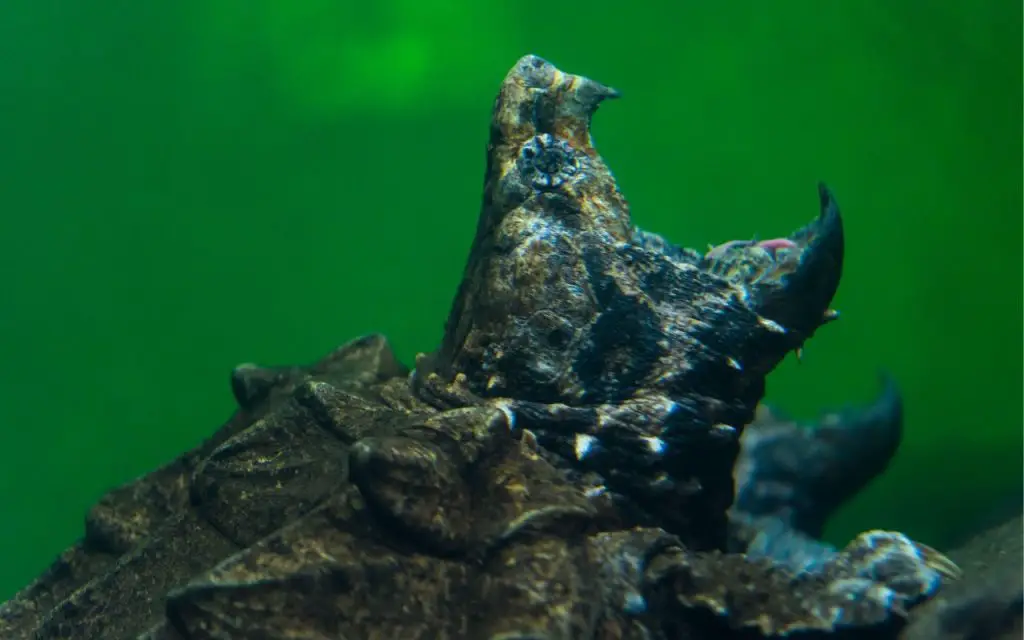The Alligator Snapping Turtle is one of the largest freshwater turtle species in the world. Let’s take a look at what else makes it unique…
Last updated on June 3rd, 2023 at 01:54 pm
If you want to know more about the Alligator Snapping Turtle, you’ve come to the right place. Read on to learn about its life cycle, characteristics, habitat, and care. After you’ve read these facts, you’ll be well-equipped to either keep one as a pet or hopefully observe one in the wild.
Characteristics
The Alligator Snapping Turtle (Macrochelys temminckii) is a reptile with a long, thick shell. The turtles are solitary creatures with yellow patterns around their eyes and often an algal growth covering their carapace.
While they are not aggressive in nature, they do not like to be around people. If they feel threatened, they may snap at the human with their powerful, hooked beaks.
The Alligator Snapping Turtle is one of the largest freshwater turtles in the world. Adults can weigh up to two hundred and fifty pounds – though their weight varies hugely.
Its shell has three rows of ridges, which resemble the skin of an alligator. Its eyes are located on the sides of the head. Its shell is rough and brown, blending in perfectly with dark or muddy water.
Alligator snapping turtles live in rivers and streams in southeastern United States. They can be found in Florida, the Panhandle of Texas, and the Gulf Coast region.
They are found in small streams, bayous, and lakes throughout these habitats. Their range in Indiana is believed to be extremely small, although they do occur in the state.
Habitat

Its habitat is in south-eastern North America, where it thrives in muddy bottoms. Like the Fly River Turtle, it likes to stay submerged unless laying its eggs.
Although they can tolerate cold winters, they prefer warm climates. They are mainly aquatic and rarely come onto land except to lay their eggs. The best place to see this amazing creature is in the wild, in clear water where they occasionally wander when young.
The Alligator Snapping Turtle is a critically endangered species and their habitat is being threatened by pollution and other human activities. Their breeding grounds are being flooded and replaced by crops.
Pollution from pesticides is also a problem. Damming of rivers also has a significant impact on their habitat. Fortunately, there are some things you can do to help protect this turtle and its habitat.
Supporting turtle conservation groups and charities is a good start, as well as volunteering to help with studies if you live within their geographic range.
Listed below are some things you should know about the Alligator Snapping Turtle’s habitat:
- They like still water
- subtropical to warm-temperate climate zones are preferred
- adults need deep water
- adults need habitat with healthy fish populations
The Alligator Snapping Turtle’s diet consists of mollusks and amphibians. Their diet consists primarily of these animals, but it will also feed on terrestrial worms and even eat small American alligators.
It is very elusive, so you should be prepared for a long wait to see it. Unlike other aquatic turtle species, these turtles are not social, and you rarely if ever see them bask together.
How rare is the Alligator Snapping Turtle?

The Alligator Snapping Turtle is a species of freshwater turtle native to the Mississippi River basin. Its head is about the size of a basketball and its shell has a maximum length of 28 inches.
While their populations have been severely reduced in recent years by unregulated harvesting, there is hope that they will make a full recovery. They have been given both federal and state protection in the US.
The Alligator Snapping Turtle is the largest freshwater turtle in the world, with an adult male measuring up to 80 cm in length and weighing about 90 kg. Legend has it that a specimen weighing 183 kilograms was discovered in Kansas in 1937.
Its head features a large hooked beak, and its tail has long, muscular legs. The skin of the Alligator Snapping Turtle is heavily wrinkled, and partly covered with warty growths.
Lifespan
Alligator snapping turtles can live for up to ten years. Despite their long lifespan, alligator snapping turtles are vulnerable to predation when young.
They eat insects, fish, frogs, and small mammals, but also occasionally prey on American alligators. Alligator snapping turtles have a worm-like tongue that they use to lure prey into their mouths. This is called lingual luring.
The alligator snapping turtle mates in the spring and lays eggs two months later. Incubation takes between one hundred and forty days.
The temperature at which the eggs develop determines the sex of the offspring. Incubation occurs in cooler temperatures than in warmer ones, and female turtles develop into male turtles.
Newly hatched turtles are similar to adult snapping turtles. These turtles reach reproductive maturity between 11 and thirteen years of age.
Average lifespan of the alligator snapping turtle is unknown, but there are reports of them living to seventy years of age.
Despite being an endangered species, alligator snapping turtles do have long lifespans in captivity. As pets, they regularly live between twenty and 70 years. Obviously, their lifespans are considerably shorter in the wild.
Captive alligator snapping turtles are usually fed on a regular basis and are protected from predators. This is the main reason why they almost certainly live longer than wild specimens.
Care

Alligator Snappers make good pets, if you can get their care right and don’t mind them getting very large.
To keep your alligator snapping turtle healthy, you should provide it with a habitat that is as close to the natural habitat as possible. Live plants are ideal, as they provide cover, shade, and hideout areas.
Live plants also help sediments fall out of the slow-moving water. Additionally, you can use driftwood or leaf litter to naturalize the edges of the pond. These items also help acidify the water and prevent algae growth.
A subtropical enclosure is important for alligator snapping turtles, because they need a warm, humid, and comfortable climate. A tank with water that is 85° F or higher will work best for a hatchling.
You must keep the temperature at the desired range for the turtle’s species, or the turtle will start to lose appetite. In addition, you should provide the turtle with a suitable heat source and provide it with the proper diet to thrive.
Alligator snapping turtles are highly vulnerable to illnesses and disease. As such, you should visit a veterinarian as soon as you notice any changes. Some diseases can be fatal and should not be neglected. A vet can prescribe appropriate medications and treatment.
Alligator Snapping Turtle Bite

If you’ve ever been bitten by an Alligator Snapping Turtle, you probably know how painful these animals can be. Whether they break your skin or not depends on the power of their size.
If they’re larger than a hatchling, they’re going to do damage!
The bite of this species can be particularly painful because of its sharp beak. It is a crushing, often lacerating bite due to the animal’s sheer strength.
It’s important to remember that you should not attempt to treat the bite yourself – calling 911 or having a friend drive you to the emergency room is the best way to get immediate treatment.
Depending on the severity of the bite, the turtle may cause bleeding or infection. Serious injury is rare, but every bit possible.
These reptiles are not aggressive when left alone, but there are some myths surrounding them that lead people to fear them.
These reptiles have jaws that can stretch up to ten inches long and have a thousand-pound bite force. If you come across a wild alligator snapping turtle, never approach it or handle it.
What do Alligator Snappers eat?
Alligator Snappers spend most of their time in the water, but they may emerge to nest. Their preferred habitat is deep, murky freshwater systems. Their diets vary, but they have been known to eat small mammals, molluscs, large insects, rodents and fish.
The most active times for Alligator Snappers are during the night. They are ambush predators and often eat small fish. They can stay submerged for up to 50 minutes!
The alligator snapper is almost entirely carnivorous. It eats fish, mollusks, amphibians, and carrion. In captivity, it sometimes feeds on Alligators.
Known Alligator Snapper prey items:
- large insects
- molluscs
- fish
- rodents
- ducklings
- snakes

Largest Alligator Snapping Turtle ever caught
They’re are many, many stories of monster Snappers being caught – but most are impossible to verify. In fact, most of them seem impossible, period.
One dubious example is the long-standing record of a 403lb turtle caught in Kansas in 1937. I’d have to see this to believe it!
So far, the largest live Alligator Snapper recorded weighed in at 249 lbs. This was the absolute behemoth that lived at the Chicago Shed Aquarium for many years.
The author had the opportunity to visit this turtle as a child, and frankly, I haven’t seen a turtle as huge, impressive, or prehistoric-looking since.
